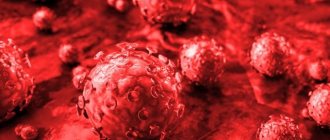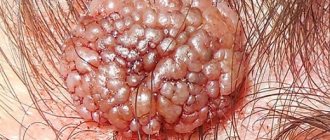Warts (also known as papillomas) are benign neoplasms on the skin that appear as a consequence of the development and reproduction of the human papillomavirus . Warts are not only a cosmetic defect that people get rid of for aesthetic reasons, but also a potentially dangerous formation that, under a certain combination of factors, can develop into skin cancer. To treat warts, it is best to consult a specialist rather than experiment with your grandmother’s methods and pharmaceutical products.
Photo 1. Contacting a specialist in a timely manner will help avoid possible problems caused by the presence of warts. Source: Flickr (Eugene Evehealth).
It is important! It is not recommended to get rid of warts on your own, so as not to provoke the development of complications. Treatment must be prescribed and carried out by a doctor.
be careful
The presence of papillomas, warts, condylomas, moles and spines on the body is the first sign of malignant melanoma!
We hasten to warn you that most medications “treat” warts, papillomas, moles, etc. - this is a complete deception of marketers who make hundreds of percentage points on drugs whose effectiveness is zero. They do not cure the disease, but only mask the symptoms.
The pharmacy mafia makes huge money by deceiving sick people.
But what to do? How to treat if there is deception everywhere? Doctor of Medical Sciences Anatoly Makhson conducted his own investigation and found a way out of this situation. In this article, the Doctor also told how to 100% protect yourself from melanoma, for only 149 rubles! Read the article in the official source via the link.
Regarding the treatment and removal of warts, you need to consult a specialist, depending on the location of the tumors:
- if warts are located on the face, neck, stomach, arms, legs, then you need to visit a dermatologist who diagnoses and treats such growths;
- if warts begin to appear in the intimate area of men, then you need to visit a urologist;
- if warts appear in the intimate area of women, then a visit to a gynecologist is recommended;
- if you have warts in the anal area, it is recommended to consult a proctologist or urologist;
- If neoplasms are located on the mammary glands of women, an examination by a mammologist is recommended.
Prevention
To protect yourself as much as possible from the appearance of warts, you need to:
- always wash your hands thoroughly;
Photo: to avoid infection, it is enough to observe personal hygiene measures
- use only personal hygiene items;
- in swimming pools and baths, use your own spare slippers, do not walk barefoot and do not touch the seats or walls with naked parts of your body;
- treat any abrasions, cuts and cracks in the skin;
- minimize situations of nervous tension;
- protect the skin from external influences and household chemicals;
- use barrier methods of protection with unfamiliar sexual partners;
- Get vaccinated against dangerous types of papillomavirus.
https://www.youtube.com/watch?v=HtAMTDHBZRY
Post Views: 1,400
Which doctor treats warts
Treatment of warts, depending on their location, can be carried out by a dermatologist, urologist, gynecologist, proctologist, or surgeon.
During the initial appointment, the doctor conducts an external examination of the emerging tumor and decides whether subsequent detailed diagnostics are required (blood tests, PCR, biopsy and other examinations are usually prescribed). The dermatologist also decides whether it is now necessary to get rid of the wart surgically or to carry out drug treatment.
Important! If, based on the examination and test results obtained, the case looks doubtfully ambiguous, then a dermatologist or urologist may recommend that the patient consult with an oncologist.
Warts are usually removed by a surgeon (laser, liquid nitrogen, excision or other methods). You can read more about methods for removing skin tumors in specialized articles on our website.
If there was a corresponding doctor’s recommendation, then the pathogenic removed wart tissue after the operation can be sent for histological examination, which will accurately determine the benignity or malignancy of the growth:
- If histology indicates that the wart was malignant, the patient is sent to the oncology center, where he will be prescribed appropriate treatment.
- If the wart was benign, then no specialized treatment other than immunomodulatory therapy is prescribed, because until new warts appear (if they ever appear) there is no risk of developing skin cancer.
After treatment and removal of the wart, you must follow some rules to reduce the likelihood of new skin growths. To do this, you need to constantly strengthen your immune system, balance your diet, avoid serious stressful situations in your life, get rid of any bad habits (especially drinking alcohol), and devote enough time to sleep and rest.
Diagnostics
To diagnose warts, a visual examination by a specialist is sufficient.
Sometimes a dermatoscope is used, which allows you to examine the tumor in detail.
But in the case of genital warts, a number of additional studies are always carried out.
This is necessary, first of all, for the early detection of precancerous conditions.
The following methods are used:
Diagnostic measures have a standard algorithm.
- First, the patient is interviewed to find out the possible mechanisms and time of infection.
- Then the site of the lesion is examined and the condition of the growths is clarified.
- Those papillomas that cause suspicion of benignity are taken for histological examination.
- To clarify the nature of the infection and the virus, a laboratory test is prescribed - polymerase chain reaction (PCR) to determine the DNA structure of the pathogen.
- If the identified manifestations are a consequence of HPV in men and have oncogenic characteristics, you will definitely be referred for a consultation with a urologist to clarify management tactics.
Photo: blood test using PCR method
Doctors' opinions on the most effective methods of treating warts and papillomas
The chief physician of Moscow City Hospital No. 62 describes his vision on this matter. Anatoly Nakhimovich Makhson Medical practice: more than 40 years.
“I have been treating people’s papillomas and warts for many years. I’m telling you as a doctor, papillomas along with HPV and warts can really lead to serious consequences if they are not dealt with.
The human papillomavirus is present in everyone on whose body there are papillomas, moles, warts and other pigmented formations. According to rough estimates, 80-85% of the planet's population has it. By themselves they are not dangerous. The problem is that an ordinary papilloma can become melanoma at any time.
These are incurable malignant tumors that kill a person in just a few months and from which there is no salvation.
Unfortunately, in Russia and the CIS countries, pharmaceutical corporations sell expensive medications that only relieve symptoms, thereby hooking people on one drug or another. That is why in these countries there is such a high percentage of cancer diseases and so many people suffer from “non-working” drugs.
The only drug that I want to recommend, and it is also officially recommended by WHO for the treatment of papillomas and warts, is Papinol. This drug is the only remedy that has an effect not only on external factors (that is, it removes papillomas), but also acts on the virus itself. At the moment, the manufacturer has managed not only to create a highly effective product, but also to make it accessible to everyone. In addition, within the framework of the federal program, every resident of the Russian Federation and the CIS can receive it for 149 rubles.”
To find out more, read this article.
Which doctor should I contact if I have a wart on my tongue?
Warts on the tongue can appear in people infected with the human papillomavirus. This virus is activated in the human body only when the immune system is weakened. New growths in the tongue can occur for the following reasons:
- lack of vitamins;
- bad habits (smoking and drinking alcohol);
- hormonal disorders;
- postoperative period;
- exacerbation of chronic diseases of the gastrointestinal tract.
Two types of warts can form on a person’s tongue:
- Flat (rounded, clearly defined contours, rich shade). They have a flat shape, so they do not cause serious discomfort to a person. If multiple growths are present, immediate removal is indicated.
- Genital warts. Neoplasms of this type have the form of elongated papillae; in the absence of adequate treatment, they grow, forming tumor lesions. They often form on the side surface and tip of the tongue. There is a high probability of their injury, so immediate removal is also indicated immediately after formation.
Initially, with such a problem, it is recommended to consult a dermatologist who diagnoses and treats warts located on the arms, neck, legs, back, stomach and other parts of the body.
If it is necessary to remove warts located on the tongue, a dermatologist can send the patient to a dental surgeon who will conduct an examination and recommend the most appropriate method for removing the tumor (depending on the location of the wart, its type, general condition and age of the patient).
Removal of warts on the tongue can be done in various ways:
- laser;
- cryodestruction;
- electrocoagulation;
- radio wave technology.
It is strictly forbidden to remove warts on the tongue using traditional methods, because in this case there is a high probability that the tumors will not be completely removed. And this can already cause their transition to another, more dangerous cancer form. Most often, when removing warts from the tongue on your own, the infection spreads throughout the entire oral cavity.
Types, signs and causes of occurrence
There are the following types of warts:
- The vulgar type occurs on the hands of schoolchildren. Appears as a pinkish-pale nodule. If you remove the largest one (the uterus), the remaining warts will disappear on their own. They occur against the background of microtraumas, low immunity, and sweating.
- Flat formations are observed up to 25 years. Flesh-colored, smooth. They often develop on the neck, face and back of the hand. May occur on the penis.
- The plantar type is considered the most painful. They are difficult to distinguish from calluses. Can be concave or convex. Warts appear on the feet where there is more friction. The reason for the development is similar to vulgar.
- Senile growths are observed in people in old age. This is a dark spot that eventually reaches 5 cm. They are usually not visible, but sometimes they can cause discomfort.
- Pointed ones can occur in the perineum, under the breasts, and on the genitals in women and men. In appearance they are pink, pale in color. May turn black when rubbed. They create colonies.
- Filiform.
- Chicken.
- Other viral growths.
For more information about the types of warts and their symptoms, see the video below.











